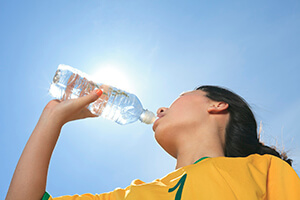Educate your teen athlete about heat-related illness
The high school sports season is returning. The beginning of football, cross country, soccer and other sports is a good time to be aware of exercise-related heat illness.
Most parents who grew up locally don’t need to be reminded that heat stroke can a life-threatening condition that needs to be taken seriously. In 2001, Korey Stringer, a Pro Bowl offensive lineman for the Minnesota Vikings died at age 27 when he suffered heat stroke during the team’s training camp.
But most high school athletes returning to the practice field today were either not yet born or too young to remember Stringer’s death. And many young athletes may be too competitive or engaged in their sports that they may not recognize the signs and symptoms of heat-illness. Or if they do, they may not take them seriously or they may try to “tough” through them.
Here are a couple of important things to remember about heat-illness and how to prevent it:
- It takes time to adjust to the conditions. It’s important to know that it takes time getting one’s body used to the heat and summer conditions. Early in the season, take time to rest and get used to the elements. A good example of easing into the sport season is the Minnesota State High School League (MSHSL) rules not allowing football players to wear full pads for the first four days of practice, not allowing contact practices for the first week and not allowing two practice sessions on back-to-back days over the first two weeks.
- Communicate with coaches. Your child may be at risk of heat-related illness if he or she is obese, is getting into shape or if they have had a heat-related illness in the past. If this is the case, be sure to communicate your concerns to your child’s coach. The MSHSL has guidelines on how to safely conduct practices for all athletes in hot weather throughout the season. They also have established when conditions are too dangerous that games should be postponed or cancelled. To learn more about your school’s plan for practices and games during hot weather, talk to your child’s coach and school officials.
- Know how your body works to keep you cool. Sweating is the main way your body tries to cool itself. But during a hot and muggy day, sweating can become less effective and your body temperature can rise as a result. Drinking water is a great way to cool your body, but sports drinks have been developed to replace essential vitamins lost when you sweat. So be sure to also use those when the weather is particularly hot.
- Hydrate before, after and during. Encourage athletes practicing in hot weather to drink water or sports drink before, after and during their activity. Athletes should drink 4 to 8 ounces every 15 to 20 minutes to replace what the body loses during exercise.
- Educate yourself on the warning signs. One of the first signs of heat illness are muscle cramps, often in the legs. Athletes who experience these should stop exercising, stretch and drink additional water or sports drink. In general, if an athlete’s cramps improve — he or she can resume playing and practicing.
- Be familiar with the signs of heat exhaustion. When you start feeling fatigue, vomiting, dizziness and/or are faint or light-headed — these are signs of heat exhaustion. Someone showing these signs should stop exercising, be taken to a shaded or cool area, be given cool fluids, cooled with ice packs and/or immersed in water. If he or she does not improve quickly or is unable to drink, you should call 911 and get emergency medical care.
- Call 911 for anyone experiencing heat stroke. If someone has heat exhaustion and is unable to cool themselves, they may move into heat stroke where they experience seizures, shock or cardiac arrest. This is an emergency and you should call 911 and get immediate medical care for these individuals.
